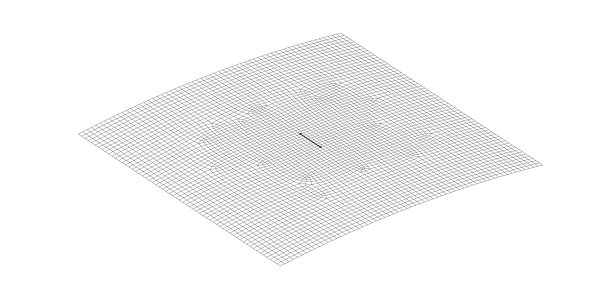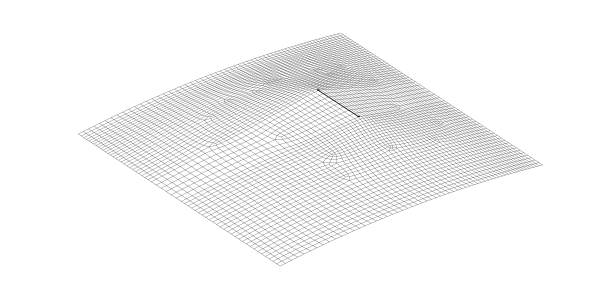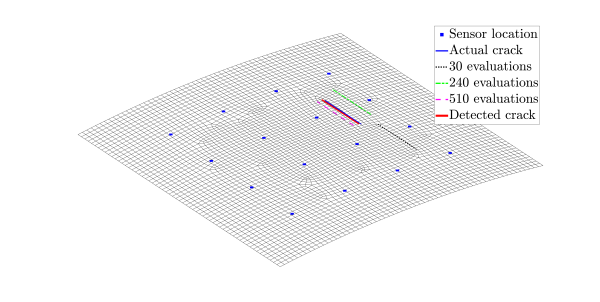Simaero
Simulation-Driven and Online Condition Monitoring with Applications to Aerospace
Overview
The main objective of the project is to incorporate advanced numerical models for damaged structures and solids within a Structural Health Monitoring (SHM) framework, with applications to aerospace structures. In order to investigate different possibilities for the use of models in SHM, two application scenarios are considered:
Detection of damage in advanced stages in operating conditions. This scenario involves the detection of cracks of larger size under unknown operating loads using vibration measurements, such as accelerations and strains. In this case, two challenges are posed with respect to the use of models. The first one is related to computational time, which has to be low enough to allow for online application. The second one stems from the fact that the exact operational loads are not known.
Detection of damage in early stages in testing conditions. This scenario involves the detection of cracks of small size using guided waves, generated and measured by piezoelectric transducers. Then, the damage detection problem can be formulated as an inverse problem involving the repeated solution models for different crack locations and sizes. As in the previous scenario, computational time becomes also an issue, while flexibility with respect to the representation of damage is also required.
Methods
To overcome the challenges described above, a series of methods need to be employed, some of which are specifically developed for the needs of the project.

Both standard and enriched finite element methods (FEM) are employed to simulate cracked solids and shells. Cracks are either explicitly meshed in the case of standard FEM, or represented by appropriate enrichment functions in the case of enriched FEM.
For the case of wave propagation in cracked solids, explicit solvers are combined to enriched FEM with specialized enrichment functions to increase efficiency. Appropriate mass lumping schemes are employed to yield critical time steps comparable to standard finite elements.
As already mentioned, a critical step for the application of numerical models in realistic SHM application is the substantial reduction of the associated computational time. To this end, state of the art model order reduction (MOR) techniques are combined with specifically developed mesh morphing methods to construct parametric reduced order models (ROMs) that can reproduce the behavior of their high fidelity counterparts at a reduced computational time over a range of parameter values. For application to crack detection problems, these parameters are geometrical features of the cracks, allowing the ROM to accurately represent the response of the structure for a variety of cracked configurations.
Output only damage indicators
In this approach, damage sensitive features, such as transmissibility, are employed, which can be evaluated using only output data and should in general be insensitive to the exact form of the loading. Assuming that the general form, but not the exact instantiation, of the load is known, these features can be evaluated for both the measured and simulated response. Then, optimization can be employed to match the values of the indicators for the two responses, yielding information regarding damage as a result.
Particle filters for input estimation and damage detection
As an alternative, particle filters can be employed to match, in an online fashion, the measured and simulated response, while estimating both the input and damage. This approach has the added advantage of providing an estimate of the full time history of the response at any point of the structure.
Cracked Cylindrical Panel Example
 Morphed mesh
Morphed mesh 3D-deformed mesh for a cracked cylindrical panel
3D-deformed mesh for a cracked cylindrical panel Crack detection in a cylindrical panel under dynamic loading. Detected cracks after different numbers of model evaluations.
Crack detection in a cylindrical panel under dynamic loading. Detected cracks after different numbers of model evaluations. Crack detection in an experimental wing box panel under dynamic loading. Detected cracks after different numbers of model evaluations.
Crack detection in an experimental wing box panel under dynamic loading. Detected cracks after different numbers of model evaluations.
Experiments*
Experiments are carried out to further investigate the potential of the developed techniques for application to real life scenarios. A collaboration has been established with IMITec, a Swiss company specializing in non destructive testing for aerospace structures, to design and perform a series of experiments involving crack detection in aeronautic panels using guided waves.
*Currently all experimental activity has been suspended due to the COVID-19 situation.